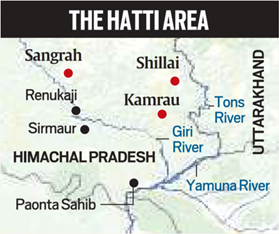

30th April 2022 (6 Topics)
Context
Centre would consider favourably the Himachal Pradesh government’s request for inclusion of the Hatti community in the list of Scheduled Tribes in the state.
About
Hattis:
- The Hattis are a close-knit community who got their name from their tradition of selling homegrown vegetables, crops, meat and wool etc. at small markets called ‘haat’ in towns.
- The Hatti community, whose men generally don a distinctive white headgear during ceremonies, is cut off from Sirmaur by two rivers called Giri and Tons.
- Tons divide it from the Jaunsar Bawar area of Uttarakhand.
- The Hattis who live in the trans-Giri area and Jaunsar Bawar in Uttarakhand were once part of the royal estate of Sirmaur until Jaunsar Bawar’s separation in
- Due to topographical disadvantages, the Hattis living in the Kamrau, Sangrah, and Shilliai areas lag behind in education and employment.
Societal norms of Hattis
- The Hattis are governed by a traditional council called Khumbli, which like the khaps of Haryana, decide community matters.
- The Khumbli’s power has remained unchallenged despite the establishment of the panchayati raj system.
- The two clans have similar traditions, and inter-marriages are commonplace.
- There is a fairly rigid caste system among the Hattis — the Bhat and Khash are the upper castes, while the Badhois are below them.
- Inter-caste marriages have traditionally remained a strict no-no.
Since when have the Hattis been demanding tribal status?
- The community has been making the demand since 1967, when tribal status was accorded to people living in the Jaunsar Bawar area of Uttarakhand, which shares a border with Sirmaur district.
- Their demand for tribal status gained strength because of resolutions passed at various maha Khumblis over the years.

More Articles


